Introduction
Welcome back to another exciting edition of graphs, charts, and conclusions! As the title suggests, we’ll be taking a look at the first month of Mental Misstep in Legacy to examine how it’s changed the format. Actually, a month isn’t quite accurate; it’s been six weeks since I gathered the data and will be about seven and a half once this is published, but “Six Weeks of Missteps” didn’t sound quite the way I wanted the title to flow. Regardless, this time around, I was prepared and practiced so I can share the information I’ve assimilated in the best possible way. So, without further ado, let’s get on to some back story.
For those of you who don’t know, this is the follow-up to my first article analyzing Mental Misstep, which isn’t essential reading for this piece, but may be helpful. For those of you who didn’t read the first article on the subject, I’d like to start off with some definitions of a couple key terms that will help in reading this.
Expected – This is the term I’ve used to say “If every deck examined were represented equally, this would be the outcome you’d expect.” This number is calculated by adding the number of cards that fit a trait (for example, 1-cost removal spells) per deck and dividing it by the number of different decks, which in this case is 71.
Weight – This is the term used to express the function of adding all of a deck’s finishes and dividing that by the total number of decks in all the Top 8s. The percentage is then the weight, which is multiplied by the number of cards that meet a trait (all of Merfolk’s AEther Vials). After adding together all of the modified values, we’re left with a number that can be compared with the expected average to show in graph form how well decks with different strategies are doing against the field.
As an improvement over last time, you can check the spreadsheets yourself right here. The sheets (there are five) are hosted on Google Docs, and you can do some editing with them without signing in, although many of the charts didn’t survive the upload to Google Docs, so watch out for those. I’ve also provided a sample list for nearly every deck that I’ve analyzed, which can be found in this document.
The Numbers
I guess that the best place to start is the beginning. For this article, I looked at twenty-eight events over the last six weeks. The criteria that I used for these events is that they needed to have a full Top 8 published online, and the event needed to have at least thirty-three players, which results in a six-round event. I was only interested in the decks that made Top 8, so no preferential regard was given when a deck won an event. In all, I identified seventy-one different decks from the 224 total decks that placed in these events. These are their stories.
The Decks
Once again, you can check these numbers in the spreadsheets to get a better look at the numbers I don’t present.
Before Mental Misstep, the top deck was Junk, with 12% of all Top 8s, but this time, Merfolk had the highest number of placings with 23, making up roughly 10% of the entire field of Top 8s. This is significant not only because it confirms Merfolk as the most successful deck in the format, but because 10% is nearly exactly where Merfolk stood the last time we checked in on the format—10% both before and after a pivotal card for the deck. The conclusion that I draw from this is that the printing of Mental Misstep has actually improved Merfolk’s place in the metagame by 0%. In fact, the cutting of Spell Pierce is the obvious reason for the strength of Natural Order decks in the metagame at the moment, but I’m getting ahead of myself.
The second most common deck in Top 8s was U/b/g aggro-control decks, with 5.36% of the finishes under its belt. I distinguish U/b/g aggro-control from Team America by the inclusion of Dark Confidant over Tombstalker and Stifle. The disparity between the top deck Merfolk at 10% and the second most common deck is huge, meaning that you can expect to see nearly twice as much Merfolk as you can any other deck. This is a trait we see repeated in GP: Providence Day 2, where Merfolk commanded 20% of the field, while Zoo, the second most common archetype, made up only 10% of the Day 2 metagame. Merfolk has consistently proven itself to be a resounding force to be reckoned with in Legacy.
I made a graph to briefly look at some the of the biggest movers over the last six weeks:
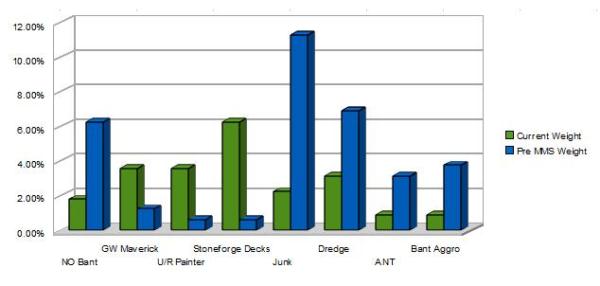
The most remarkable change we see is Junk, which lost 9% of its weight over the last month and a half, now making up just around 2% of the Top 8s we see. Natural Order Bant decks also fell by the wayside, but this is a trend that can also be attributed to the success of the U/G/r builds of the deck that have been doing so well. Regardless, the trend of NO Bant and Bant Aggro on the downswing may be changing in the coming weeks as the archetypes put up most of their numbers in the most recent few events.
Despite the strong finish at the Grand Prix, Dredge has a much smaller market share of finishes in the money in most other events. The same is true with both ANT and TES, which were previously on the downswing even before Mental Misstep, despite the fact that we were in a relatively combo heavy metagame.
The loss of those decks were made up by others, though. Painter decks are finally experiencing a good level of success after a string of near misses previous to Mental Misstep. G/W Maverick (aggro-control) also has some strong improvements over the last few weeks and looks to be solidifying its place in competitive circles now. The strongest gain came from the decks playing Stoneforge Mystic; I charted all of these under one heading since there were so many of these decks. Now with both Batterskull and Mental Misstep in the equation, decks with Stoneforge Mystic have gone from under 1% of successful finishes to a very respectable 6%, with little sign of slowing down.
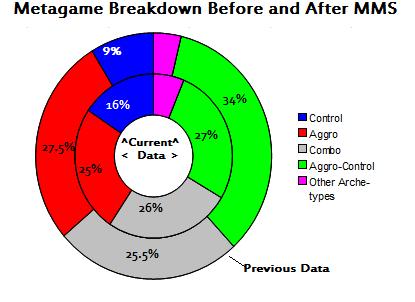
These dual pie charts are helping to display the difference between the shape of the metagame before and after the impact of Mental Misstep. Notably and surprisingly, you can see that the biggest winners were control decks, gaining 7% of all successful finishes, and the biggest losers were aggro-control decks such as Junk and Bant Aggro losing nearly 13% of their stake in the field. Modest losses were also seen in aggro and combo decks, while there was a small gain in decks that fall under other archetypes, such as Enchantress and Pox.
The Cards
Among the different metrics I started tracking was how well specific cards were doing in the format. Gathering the data was tedious work, since I decided to do it after I had gathered all of the other data, but the problem of how to present the information became a gigantic dilemma. The first option was to give a small graph for each card and a short description, but even then that was going to eat up close to five pages, which was a bit lengthier than I really wanted to go. The second option was this:
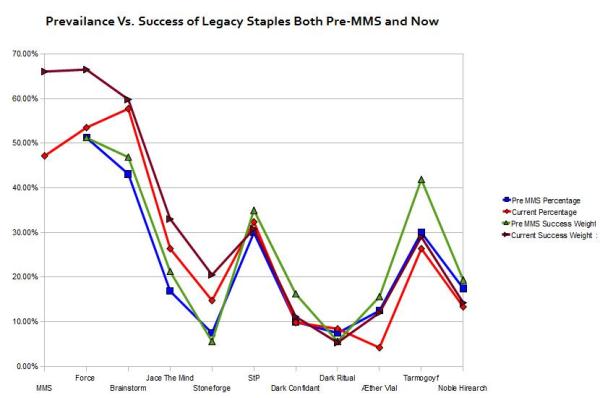
The second option was a gigantic chart that was going to require a bit of explanation and be a bit messy. There are two different traits being tracked here. Percentage is the number of decks that played these cards among successful decks divided by the number of decks that could have been playing them among successful decks. For example, there were approximately 134 Mental Missteps played among all decks that made Top 8 in the data pool, and there could have been 284 total Mental Missteps played among all decks. So we saw about 47% of the Mental Missteps that we possibly could have seen, assuming every deck played the card. The Success Weight is calculated by adding together the weight of every deck that played the card in question. The larger the disparity between the percentage played and the success weight gives some hints as to how successful decks with those cards have been. These traits are tracked for both before Mental Misstep and after, so you can see how the dynamic changes as New Phyrexia is added to the equation.
In the example, we see that Mental Misstep is represented in about 47% of all successful archetypes, but those decks are accounting for close to 68% of all finishes in events. The biggest decline in a card seeing play is that of Tarmogoyf, who now makes up 14% less of decks than he did just a couple months prior; AEther Vials are now making up about 8% less of decks as well. The largest gain other than Mental Misstep was actually Brainstorm, which gained 14%, and Jace, the Mind Sculptor, which gained 10% among decks doing well, indicating a strong shift toward Blue strategies.
The most successful cards for their percentage have been Mental Misstep, performing 19% over the amount of decks it makes up, followed by Force at 13% over, Vial at about 8%, Jace at roughly 7%, and Stoneforge Mystic rounding them out with just under 6% performance above what would be expected.
For inquiring minds, the most-played cards went in this order:
2. Brainstorm
5. Jace, the Mind Sculptor/Tarmogoyf
Composition of a Legacy Deck
Before we get started with the charts we’ll be looking at the most, I’d like to explain how to interpret the numbers we’ll be encountering in these sections. Since this data is all aggregated from the Top 8s of various events, these are meant to be used as a predictor for a Top 8. When reading the number “1” as a descriptor for something, that means the average deck has at least one of these; when you multiply that by 8, for each of the decks from the top of an average event, you’ll get the number 8, which is two playsets. This means that in the average Top 8, there will be two sets of a copy of a card, or card type when it’s defined with the descriptor of “1.” Some card types will appear several times in a Top 8, and some will have a value that is below a set, meaning you’re probably not going to see one every Top 8, but you may in every two or three Top 8s.
With a few minor assumptions and a lot of averaging, you too can get something that looks like the following:

Above, you can see the actual versus expected costs in the average deck. I will try to avoid barraging everyone with too many numbers this time around, so I’d like to suggest the important aspects are that we’re seeing slightly more 1s and a bit more 5s in the average decks, while both 3- and 0-cost spells are seeing less play, as well as spells with a variable mana cost such as Green Sun's Zenith and Engineered Explosives.
Comparing this to the data set I presented in the last installment, our changes over time look like this:
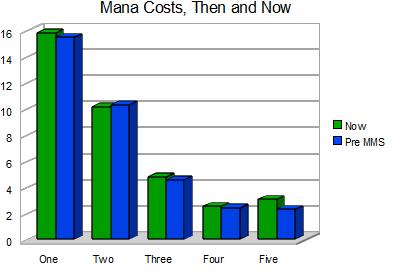
While curves did actually go up, as many people expected, we’re also seeing a small but noticeable jump in 1-drops. However, the largest jump is in 5-cost spells due to both the increase of Blue-based decks and the popularity of Batterskull. 3-drops also increased, likely on the back of Vendilion Clique, but Vedalken Shackles, Knight of the Reliquary, and Pernicious Deed are all popular and powerful cards as well.
What One Mana is Doing
This is where I’d like to take a look at what exactly 1 mana is getting people in Legacy at the moment. The breakdown is for cards that will accelerate the player in one way or another, cards that will dig for other cards, removal, disruption, creatures, and creatures that have the primary job of attacking the opponent. The final descriptor is a category I called “Broken,” which is an arbitrary category where I determine which 1-cost spells will heavily alter the game if not answered; examples are AEther Vial, Goblin Welder, Dark Ritual, and Glimpse of Nature.
First, we’ll take a look at the actual vs. expected values of these cards to get an idea of where the metagame is:

The conclusion here is that we’re seeing more disruption and also more high-impact cards in the Top 8s of events than we’re seeing of removal, attackers, or even acceleration. Utility creatures and accelerators are a bit under what we’d expect to see considering the seventy-one decks that make up the metagame, but it isn’t too far off. Comparing the actual data this time around from what we saw the first time, I compared these values, giving us this chart:
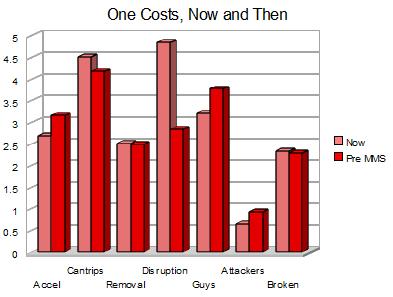
As I had predicted, we do in fact see a sharp increase in disruption; mostly Mental Misstep replacing cards such as Thoughtseize, Spell Pierce, and even sometimes cutting into slots for Force of Will, removal, and cantrips. Unremarkably, we’re seeing fewer creatures and even fewer attackers, meaning that now we can expect about one deck with 1cc attackers such as Zoo for every sixteen decks that make a Top 8.
Keeping in trend with the last article, I’ll be taking a closer look at some of the categories a bit more in depth.
Acceleration

For now, Vials is nearly entirely a descriptor for Merfolk, but there are some Goblins and even a couple of other decks using the card. Considering how few different decks are playing the card, we’d only expect to see it in a deck with AEther Vial once every two Top 8s, but in reality we’re seeing just under one per Top 8. Conversely, with Dark Ritual and similar one-shot mana effects, we’d expect to see that card make an appearance as a four-of in every other event, but it’s actually been performing a bit under that mark, as combo decks have been doing relatively weakly recently.
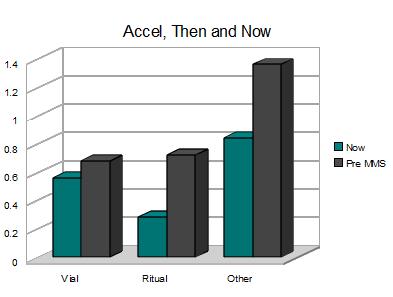
I wasn’t tracking as many card types the last time we looked at acceleration, so all creatures that produced mana and Green Sun's Zeniths were covered under the heading “Other,” which I compensated for to compare these numbers. You can see in a bit of detail how the impact of Mental Misstep and the rest of the New Phyrexian metagame has impacted the number amount of 1-cost acceleration across the board with a stark reduction in the amount of Ritual effects we’ve seen in the metagame.
Removal

Taking a closer look at 1-mana removal, we’re seeing that overall there is less removal at the 1-mana mark, but those changes are slight. The Bolt descriptor covers both Lightning Bolt and Chain Lightning, as we tend to see in both Zoo and NO R/U/G. Zoo was essentially the only deck to be playing Path to Exile. This is a bit dry to look at in a bubble, but let’s give it some context:

Now, that’s much better! We can observe how Plow has seen a drop and Lightning Bolt and Chain Lightning have an even larger rise, almost mirrored by Grim Lavamancer. Path to Exile wasn’t seeing much play then and still is not seeing much now. For a bit of a visual, you can expect to see a full set of Path to Exiles main-decked once in every thirteen events. The big losers were the miscellaneous removal spells such as Ghastly Demise and Innocent Blood, which are seeing less than half the meager play there were seeing to begin with.
Problem Cards
Also known as the “Broken” cards, this was previously the major source of weight when I argued my point against Mental Misstep: that the problem cards were not prevalent enough to warrant playing the card in high volumes. This time around, I’d like to take a more objective look at the matter and see what the impact of the card has been on problematic 1-mana cards.
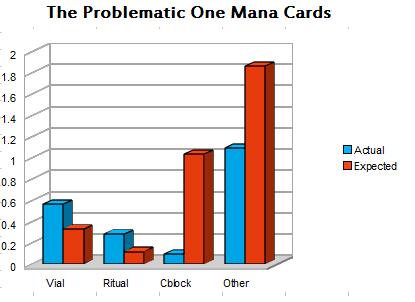
Cblock stands for Counterbalance lock, something dreaded by most Magic players for some time. It seems rather small now, but it was still interesting to track. The number for Vial is mirrored from the Accel section because any deck playing with Mental Misstep should be highly concerned with a resolved Vial. Those with keen eyes will notice that the Ritual numbers are not the same as the Accel section; the reason for this is that there are decks that will get out of hand with a resolved Ritual, such as ANT or TES, and then decks that are simply accelerated into a longer game plan with the card, like The Gate (MBC) or Eva Green (B/g aggro-control). When we consider this, it is not pivotal to counter some of these Rituals, but it is for others, so I wanted to take that into account. All other manner of problem cards are under the Other descriptor, which covers Glimpse of Nature, Goblin Welder, Enlightened Tutor, and the like—these are the kinds of cards that have been really hit by Misstep, with the exception of Sensei's Divining Top from a Counterbalance deck. Interestingly, however, we’re seeing more Vials and more Ritual effects with potency than we would normally expect.
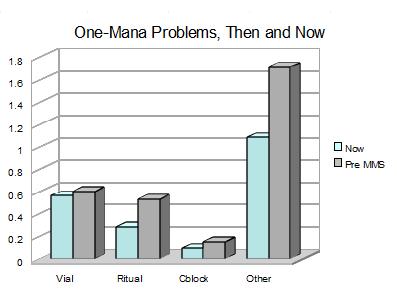
Taking a closer look at how these cards have been impacted since New Phyrexia, we’re seeing these cards losing strength across the board. The losses in Rituals and miscellaneous broken cards are remarkable. The losses in Counterbalance locks are small and take weight away from the fact that we were not exactly seeing a Counterbalance deck in every Top 8 before Mental Misstep came onto the scene. That is something I’d expect to see change over the next few months, however.
Disruption

There will be no comparison, since this is a new metric that I’m tracking, but let’s take a look at it. As it stands, we can expect roughly twenty Mental Missteps in every Top 8, which dwarfs any other form of disruption you’d expect to see. This incredibly high number of Missteps is part of the reason why Natural Order decks are gaining so much steam at the moment, since there are practically only four counters in a given Blue deck that can answer the card. Spell Snare is a card that has almost certainly gained stock since the printing of Misstep, since so many of the aggro-control and control decks want the ability to reach ahead in curves, but even considering it, we’re not seeing quite the number that we may expect. Thoughtseize has lost a significant amount of its relevance since now both Storm and Rock decks are on the downswing and U/b/g decks are looking to Mental Misstep and Inquisition of Kozilek to cover their disruption needs. Even considering the shift of decks away from Thoughtseize, the disruption packages using Spell Pierce, Inquisition of Kozilek, Duress, and other cards are still far underperforming compared to the level we would expect to see them at.
Conclusion
I took a much more objective stance with the information this time around; I was mostly interested to see and show how the format is currently being changed by Mental Misstep. The format hasn’t really adjusted in the way that I expected it to, even with Mental Misstep being successful, but I think now that decks like Aggro Loam are starting to get more attention, we may see the cogs turning a bit in the machine that drives the format. I think that the biggest surprise to me was that Merfolk has no larger of a slice of the metagame pie than it did before Misstep, although it is clearly now the dominant deck in the format. I think that the pilots behind Merfolk need to do some matchup analysis and determine what changes can be made to really fight the problematic matches.
On the other side, I was really happy to see that Goblins has been placing in the last couple weeks and that Goblins players are finally coming back out into the open to do battle. Goblins is a beating against most Blue decks, and I don’t see that changing too much with the Blue decks having a tool that helps them in the early game. Goblins was never winning against Blue in the early game; it was always an attrition war that Goblins is so well-equipped to fight and win.
Thankfully, I was able to stop myself short of the thirty-six pages that the last article came to, so I was even left with some time to enjoy myself. Next week, I’ll keep in trend with being right on time for hot topics, and I’ll be discussing my solution for the rising cost of Legacy staples. I’m pretty sure it’s a bit different from everyone else’s, so check it out. It should be interesting. Until next week, adieu!
~ Christopher Walton in the real world
im00pi at gmail dot com
Master Shake on The Source
@EmperorTopDeck on Twitter























